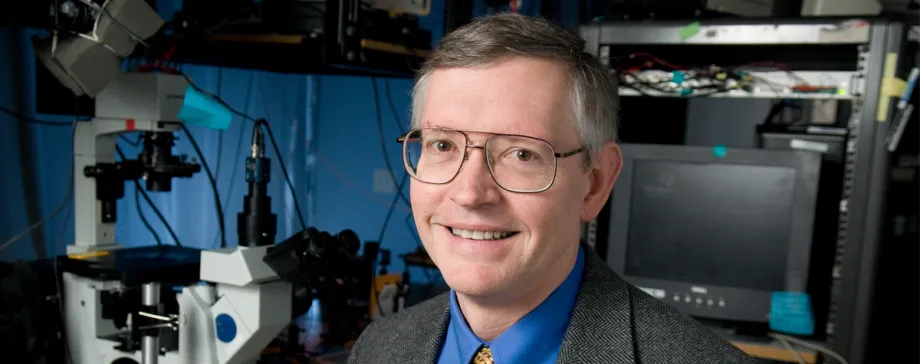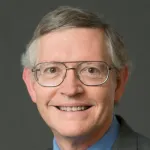
Stanford Report - October 8, 2014 - by Bjorn Carey
The ability to dive deeper and deeper into human biology and visualize the inner workings of cells at a molecular level is central to modern research and medicine. Today, W.E. Moerner, the Harry S. Mosher Professor of Chemistry at Stanford, was awarded the 2014 Nobel Prize in Chemistry for his role in developing the microscopy techniques that make this possible.
Moerner shares the recognition, and the $1.1 million prize, with Eric Betzig of Howard Hughes Medical Institute and Stefan W. Hell of the Max Planck Institute for Biophysical Chemistry in Germany.
"The path-breaking work of Professor Moerner and his colleagues has made a major contribution to our ability to observe molecules at the smallest scales, opening up new possibilities for discovery in areas ranging from disease management to drug development," Stanford President John L. Hennessy said. "The Nobel Prize recognizes this remarkable work, of which all of us in the Stanford community are immensely proud."
This is the fifth Nobel Prize awarded to Stanford faculty in the past three years.
Finding single, glowing molecules
Moerner earned three bachelor's degrees from Washington University in St. Louis in 1975 and master's and doctoral degrees from Cornell University in 1978 and 1982. From 1981 to 1995, he was a research staff member at IBM, and it was there that he made the first of two major discoveries that were key to his role in the Nobel-winning work.
In 1989, he used laser-based techniques to visualize a single molecule, a ringed hydrocarbon called pentacene. The accomplishment has been described as like finding a needle in a haystack the size of an NFL stadium.
"Prior to W.E.'s work, we all believed in molecules, but no one had ever seen one," said his long-time colleague in the Stanford Chemistry Department, Professor Richard N. Zare. "He was the first one to allow us to actually visualize a molecule. It opened up all sorts of new experiments in which you can see how cells divide, how the ribosomes can make proteins, and how the cells work."
Moerner joined the chemistry faculty at the University of California, San Diego in 1995, and there made the second major discovery, albeit somewhat by accident. He and a colleague, Robert Dickson, were looking at cells tagged with a green fluorescent protein. Instead of staying brightly lit, the tags turned on and off, fluorescing at different wavelengths of color depending on how they were manipulated.
"They are like little beacons, or flashlights, telling us where the structure is and in precise detail going far beyond the optical limit of diffraction," Moerner said.
This led to an entirely new way of looking at living cells.
The birth of 'nanoscopy'
The ability to resolve objects with optical microscopy had been limited by the wavelength of light; anything smaller than about half a micron would appear somewhat blurry. And although electron microscopy and X-ray technologies could surpass this level of detail, these techniques required scientists to kill the cell in order to make the observation.
By keying in on fluorescent light, however, Moerner and his co-winners were suddenly able to see much smaller molecular structures.
"With light, you can't observe details smaller than less than half a micron," he said. "You can go to factors of 10 or more below that level using fluorescence."
Moerner joined the Stanford faculty in 1998, attracted by the opportunity to apply his work to new fields.
"I knew that Stanford was an incredibly exciting multidisciplinary environment with so many experts that it would be incredibly stimulating to my science over time, and indeed it has," he said. "We use light to probe molecules, and that involves physics and chemistry. We apply this to biology and biomedical systems. But it's very important to do precise measurement and extract as much information as possible from a single object, and we do that with concepts from electrical engineering."
Through collaborations with colleagues in medicine, biology, applied physics and electrical engineering, Moerner has helped reveal key details of how Huntington's proteins damage the brain, how bacterial proteins regulate DNA replication and cellular division in time and space, and the precise structures of the cellular antennae that, if mutated, can trigger various diseases in humans.
"We have discovered that bacterial cells are highly, exquisitely organized, and that was not known before," said Lucy Shapiro, a professor of developmental biology at Stanford University School of Medicine and a 10-year collaborator of Moerner's. "We can observe how live cells divide, molecule by molecule. This has been incredible and has opened up whole new worlds to visualize."
A call for increased science funding
Moerner took care to point out that throughout his career, much of the Nobel-winning work has been funded in part by the Office of Naval Research, the National Institutes of Health, the National Science Foundation and several other federal grant foundations.
"The support of this type of fundamental research from federal funding sources needs to continue and increase," he said.
Moerner was born at Parks Air Force Base in Pleasanton, Calif., in 1953, but grew up in Texas. His full name is William Esco, but his family called him W.E. to distinguish him from his father and grandfather, who were also named William.
Moerner almost missed getting the news. At the time of the announcement, he was in Recife, Brazil, for a conference. He had turned off his cellphone, making it impossible for the Nobel committee to inform him of his win.
"The Associated Press called our home at 3 in the morning," said his wife, Sharon. "I said, 'Are you serious?' Then NBC and KPIX called, and that made me think that this is really real."
She quickly sent her husband a "WhatsApp" text to tell him to turn on his phone, and in the meantime dialed his hotel. He had just gotten out of the shower, and was floored by the news.
"I had this feeling of incredible excitement, and my heart was racing, because you don't know if this is real or not," he said. "You never expect such things, because there are lots of scientists doing exciting things all over the world. This is possible because of the incredible work by my group of students and postdocs over a long period of time."
There was no time to truly celebrate. In the few hours before he needed to head to the airport to fly home, Moerner received dozens of calls from reporters – as well as a congratulatory email from his son Daniel, a doctoral student at Yale – and he expects to try to answer hundreds of new emails on his trip. But the ride home should at least be comfortable.
"My wife insisted on upgrading me to first class," he said. "She's wonderful."

